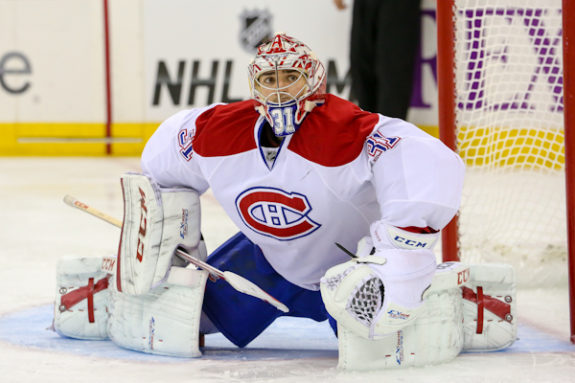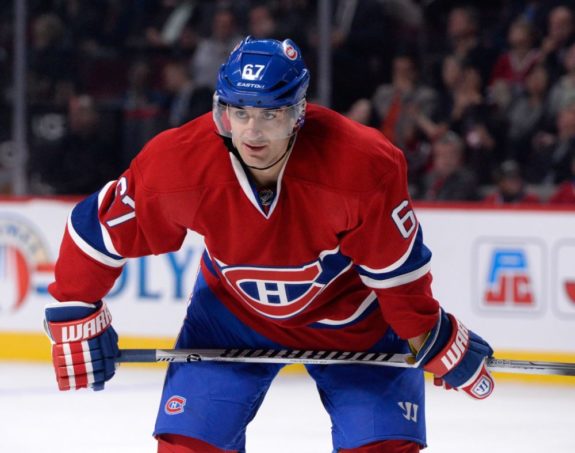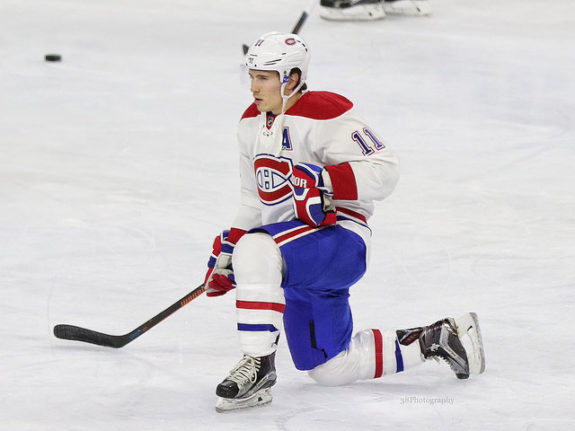Advanced stats are an amazing addition to the sport of hockey. They provide extremely useful information for teams in the hunt that are trying to get an edge. For the Montreal Canadiens, a team that isn’t consistently in the running, it’s often better to ignore those numbers and go with your gut. Sometimes it’s vital to just get back to basics.
It’s like getting the most out of a race car. There are many technical adjustments to consider for smooth operation at speed. Sometimes those fine adjustments are what get you over the hump. Sometimes they get you close and you keep looking for that one last tweak. After a while though, if you’re not finding your edge, it’s better just to get a new car.

The Canadiens obviously already have some valuable pieces. They’ve got the best goaltender in the world. They’ve got a deep blue line with a good age range. They’ve got enough pieces that a tweak or two should be enough, but it just isn’t. It hasn’t been, and it never will be. They’ve tweaked themselves to death. They need a new car.
So if you’re Canadiens general manager Marc Bergevin, how do you decide on the model? Look no further than the one provided by the most basic hockey lineup selection process of all time: choosing your starting four in the 1988 Ice Hockey video game presented by the original Nintendo Entertainment System.
Value-to-Weight Ratio
As hockey-based video games have progressed since 1988, there are now pages and pages of stats and numbers to rank individual players. The idea as a virtual GM is to acquire the best combination of players with the highest number ranking so your team as a whole can have a higher overall ranking. Obviously, the higher the ranking of a player, the more you have to give up to acquire him. This proves the value according to these games is getting the best players, period, not the players that are the best fit for your team.
The beauty of Nintendo Ice Hockey is it simplified everything. This classic game featured three types of players. There were the super fast, highly skilled skinny ones that could score like anything, but if you breathed on them or even so much as looked in their direction they’d slide across the ice and be out of the play for the rest of the period. I’ll call them lightweights.
There were the averaged-sized, fairly fast skilled players who could score pretty well and take a hit. I’ll call them middleweights. Rounding out the roster (pun intended) were the huge players you had to hit 27 times to knock over (with middleweights only, as lightweights would just bounce off) and took Chuck Norris-like slap shots, but skated so slowly you actually had enough time to hit them 27 times before they reached the blue line. I’ll call them heavyweights.
There was no default roster. There was no player-to-player separation by evaluation and comparison. There was no limit to how many of each type of player you could take, which proves the game valued each player equally. All you had to do was pick the types of players you needed to play the game the way you wanted to play it. I don’t see why the real NHL needs to be any different.
The struggle was trying to find the right balance of lightweights, middleweights, and heavyweights. This isn’t unlike the conundrum faced by Bergevin. He’s repeatedly tried a lineup consisting mostly of lightweights. That hasn’t gotten his team to the next level. At the 2016-17 trade deadline, he loaded up on heavyweights. That didn’t do much of anything either. So what next?
Over time, the logical go-to combination for Ice Hockey became one lightweight, two middleweights, and one heavyweight. By that ratio, the 12 Canadiens forwards in the lineup on any given night should be made up of three lightweights, six middleweights, and three heavyweights (for the purposes of this highly professional, scientific experiment, I’ll include enforcers and checkers in the heavyweight category). Now all Bergevin has to do is plug his current players into the categories and see where the surplus is.
Finding the Right Role
For me, the notable lightweights are Paul Byron, Philip Danault, Jacob de la Rose, Bobby Farnham, Brian Flynn, Alex Galchenyuk, Charles Hudon, Max Pacioretty, Daniel Carr, and Nikita Scherbak. The heavyweights consist of Dwight King, Andreas Martinsen, Michael McCarron, Torrey Mitchell, Steve Ott, Andrew Shaw, and Chris Terry. Seventeen total forward spots are taken up by players who are thrust into roles promoting an unbalanced playing style or skill set. That leaves Brendan Gallagher, Tomas Plekanec, Artturi Lehkonen, and Alexander Radulov as the four middleweights holding it all together.
There are 21 players ranked, so proportionately to the Ice Hockey formula, there should be five or six lightweights, five or six heavyweights, and 11 middleweights. Unfortunately, the Canadiens are a touch lightweight heavy (get it?). It’s important to note there are a few lightweights who have the potential to be middleweights if they could be placed in the proper role. With things the way they are, some players are expected to be doing things they just don’t have the ability to do.

For instance, Pacioretty has proved he’s capable of scoring at an elite NHL level. He’s also proved he frequently turns into a ghost in the playoffs, scoring zero goals in both the 2012-13 and 2016-17 post seasons, and only averaging 0.26 goals per playoff game for his career. That’s a far cry from his regular season average of 0.45 goals per game during those same four regular seasons in which the Canadiens made the playoffs. Pacioretty should probably be playing away from the top defenders of the opposition in a lower roster spot, much like Phil Kessel of the Pittsburgh Penguins.
Alex Galcehnyuk is capable of becoming a stronger asset as well. This is probably the best example of a player being used poorly in terms of role, position, and depth chart ranking. Is he a center or a winger? Is he a goal scorer or a playmaker? Like most players on the current roster, he’d probably struggle (relative to the bona fide first line contenders) if consistently played up on the first unit. The Canadiens just don’t have enough of what he needs to be able to succeed without taking away from someone else. Right now it’s clear he’s the odd man out, so it may be time to let another team take him on. In return for a quality
The Canadiens just don’t have enough of what he needs to be able to succeed without taking away from someone else. Right now it’s clear he’s the odd man out, so it may be time to let another team take him on. In return for a quality asset like him, they could acquire a stable, consistent center to help out the remaining up-and-comers. In essence, they could get what they need for Galchenyuk by dealing him.

Also, I have Tomas Plekanec as a middleweight, but if you match him against other NHL first-line centers, you might be left wanting more. Against second-line centers around the league, he looks a little more appealing. The Canadiens happen to be pretty deep on the blue line. Trading three or even four lightweights and a surplus defenceman to bring in two middleweights would allow Plekanec to move down to a more ideal second, or even third-line position.
This would instantly make the third line a scoring threat no matter who else was on it. It would allow the team to ease younger potential players such as Carr and Scerbak into depth spots while still providing them with the type of skilled centre (Plekanec) that would help them develop properly. Without a proper linemate, they’d either be wasted among checking players (like Galchenyuk was) or forced into the top six where they don’t necessarily belong (like Plekanec).
Learning by Example
Picking up more middleweights would also increase the effectiveness of current middleweights by adding to their longevity. For example, Gallagher would be less likely to be targeted physically by other teams if the Canadiens had at least one more player like, well, Gallagher. If he only had to take half the beating he takes now game in and game out, he’d add years to his prime playing form, and probably add points by shifting his focus to offense from not having to always be the only player doing what he does physically.

By identifying and accepting these needs as defined by Nintendo’s Ice Hockey, it becomes easier to detach emotionally from the names of the players and do what’s best for the long term. The Edmonton Oilers are a perfect example of this system working. They got rid of a franchise middleweight (Taylor Hall) to acquire a much-needed stable defenceman. They then signed a high-profile combination middle/heavyweight (Milan Lucic).
Only because of this were the Oilers able to promote an in-house middleweight (Leon Draisaitl). All of a sudden the Galcehnyuk, Beaulieu, and Plekanec-type players (Ryan Nugent-Hopkins, Jordan Eberle, and Benoit Pouliot) could drop down a line and make more meaningful and realistic contributions as lightweights.
The Oilers are also a good example of a team taking a struggling lightweight from another team and turning him into a valuable asset by giving him the role and depth spot more suitable to his talents. Former Canadien David Desharnais became a calming fourth-line presence for a young Oilers team. He took important faceoffs, provided a responsible checking option, and even scored an overtime winner in the 2016-17 playoffs. I think Bergevin was right to trade him and I think defenceman Brandon Davidson was a fantastic return, but it shows how seemingly disappointing players can thrive when they aren’t set up to fail.
If Bergevin did prove one thing with the P.K. Subban trade, it’s that he’s not afraid to deal a beloved big name if he feels he has to. The time has quickly come again, and hopefully he uses this design to maximize the return for his courage.